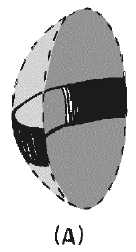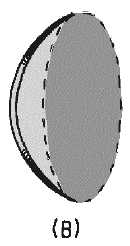3-7
Figure 3-5A.—Truncated paraboloid.
The truncated paraboloid may be used in target height-finding systems if the reflector is rotated 90
degrees, as shown in figure 3-5B. Since the reflector is now parabolic in the vertical plane, the energy is
focused vertically into a narrow beam. If the reflector is truncated, or cut, so that it is shortened
horizontally, the beam will spread out horizontally instead of being focused. Such a fan-shaped beam is
used to accurately determine elevation.
Figure 3-5B.—Truncated paraboloid.
Orange-Peel Paraboloid
A section of a complete circular paraboloid, often called an ORANGE-PEEL REFLECTOR because
of its orange-peel shape, is shown in figure 3-6. Since the reflector is narrow in the horizontal plane and
wide in the vertical plane, it produces a beam that is wide in the horizontal plane and narrow in the
vertical plane. In shape, the beam resembles a huge beaver tail. The microwave energy is sent into the
parabolic reflector by a horn radiator (not shown) which is fed by a waveguide. The horn radiation pattern
covers nearly the entire shape of the reflector, so almost all of the microwave energy strikes the reflector
and very little escapes at the sides. Antenna systems which use orange-peel paraboloids are often used in
height-finding equipment.



